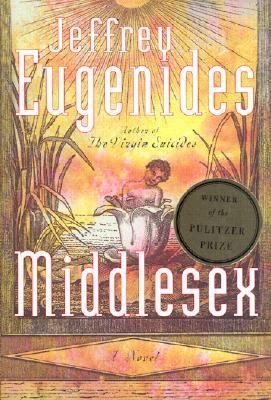
by Jeffrey Eugenides
Publishers Weekly
: As the Age of the Genome begins to dawn, we will, perhaps, expect our fictional protagonists to know as much about the chemical details of their ancestry as Victorian heroes knew about their estates. If so, Eugenides (The Virgin Suicides) is ahead of the game. His beautifully written novel begins: "Specialized readers may have come across me in Dr. Peter Luce's study, 'Gender Identity in 5-Alpha-Reductase Pseudo<->her<->maphro<->dites.' " The "me" of that sentence, "Cal" Stephanides, narrates his story of sexual shifts with exemplary tact, beginning with his immigrant grandparents, Desdemona and Lefty. On board the ship taking them from war-torn Turkey to America, they married-but they were brother and sister. Eugenides spends the book's first half recreating, with a fine-grained density, the Detroit of the 1920s and '30s where the immigrants settled: Ford car factories and the tiny, incipient sect of Black Muslims. Then comes Cal's story, which is necessarily interwoven with his parents' upward social trajectory. Milton, his father, takes an insurance windfall and parlays it into a fast-food hotdog empire. Meanwhile, Tessie, his wife, gives birth to a son and then a daughter-or at least, what seems to be a female baby. Genetics meets medical incompetence meets history, and Callie is left to think of her "crocus" as simply unusually long-until she reaches the age of 14. Eugenides, like Rick Moody, has an extraordinary sensitivity to the mores of our leafier suburbs, and Cal's gender confusion is blended with the story of her first love, Milton's growing political resentments and the general shedding of ethnic habits. Perhaps the most wonderful thing about this book is Eugenides's ability to feel his way into the girl, Callie, and the man, Cal. It's difficult to imagine any serious male writer of earlier eras so effortlessly transcending the stereotypes of gender. This is one determinedly literary novel that should also appeal to a large, general audience. Copyright 2002 Reed Business Information, Inc. Distributed by Syndetic Solutions Inc. Terms
School Library Journal: Adult/High School-From the opening paragraph, in which the narrator explains that he was "born twice," first as a baby girl in 1960, then as a teenage boy in 1974, readers are aware that Calliope Stephanides is a hermaphrodite. To explain his situation, Cal starts in 1922, when his grandparents came to America. In his role as the "prefetal narrator," he tells the love story of this couple, who are brother and sister; his parents are blood relatives as well. Then he tells his own story, which is that of a female child growing up in suburban Detroit with typical adolescent concerns. Callie, as he is known then, worries because she hasn't developed breasts or started menstruating; her facial hair is blamed on her ethnicity, and she and her mother go to get waxed together. She develops a passionate crush on her best girlfriend, "the Object," and consummates it in a manner both detached and steamy. Then an accident causes Callie to find out what she's been suspecting-she's not actually a girl. The story questions what it is that makes us who we are and concludes that one's inner essence stays the same, even in light of drastic outer changes. Mostly, the novel remains a universal narrative of a girl who's happy to grow up but hates having to leave her old self behind. Readers will love watching the narrator go from Callie to Cal, and witnessing all of the life experiences that get her there.-Jamie Watson, Enoch Pratt Free Library, Baltimore Copyright 2003 Reed Business Information, Inc. Distributed by Syndetic Solutions Inc. Terms
|